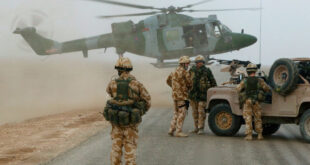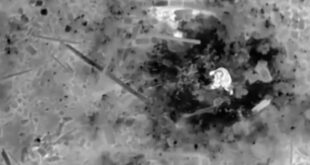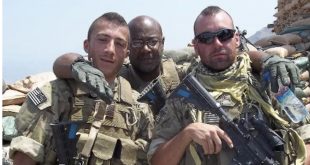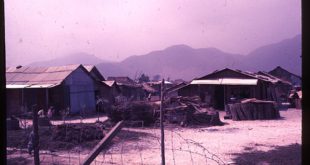By Lewis Sorley
From the April 2012 issue of SOF
THEY GOT PLATITUDES
Brigadier General Edwin Simmons, later the long-serving Chief of Marine Corps History, recalled a commanders’ conference convened by Westmoreland at Nha Trang. The room was filled with senior officers who had served in World War II and Korea, and Westmoreland told them: “At the end of World War II I wrote down some principles of war. I have them still today—on a card I carry in my wallet, and I want to share them with you. Whenever possible, feed the troops a hot meal. Make sure they have dry socks, and check their feet. Stress getting the troops their mail.” The audience had thought they were about to get something the equivalent of Napoleon’s maxims or the like, said Simmons, “and instead they got these platitudes of squad leading.”
SINGLE-MINDED PURSUIT OF ATTRITION
His approach to achieving [defeat of the enemy] was to wage a war of attrition, using search and destroy tactics, in which the measure of merit was body count. The premise was that, if he could inflict sufficient casualties on the enemy, they would cease their aggression against South Vietnam. In single-minded pursuit of this objective, Westmoreland essentially ignored two other crucial aspects of the war—improvement of South Vietnam’s armed forces and pacification.

Westmoreland describes in his memoirs how and why he came to adopt an attrition strategy as his approach to conduct of the war. There is no doubt that he himself decided on it even though, as he stresses, it was not for him the strategy of choice, merely the best remaining option—or, as he viewed it, the only other option—after his preferred approach involving operations in Laos, Cambodia, and North Vietnam had been ruled out by Lyndon Johnson’s insistence on “no wider war.”
Westmoreland confirmed the fact that, other than determining the pace of “gradual escalation” and the use of certain weapons, “the President never tried to tell me how to run the war. The tactics and battlefield strategy of running the war were mine. He did not interfere with this. He deferred to my judgment, and he let me run the war or pursue tactics and battlefield strategy as I saw fit.” Also: “I, in effect, had a carte blanche in the devising and pursuing tactics and battlefield strategy of the war.”
“THEY CARE ABOUT THE ONE”
Implementing the attrition strategy, Westmoreland prescribed search and destroy tactics. What search and destroy meant in practice was a series of large unit sweeps, often multi-battalion and sometimes even multi-division, frequently conducted in the deep jungle regions next to South Vietnam’s western borders with Laos and Cambodia, designed to seek out enemy forces and engage them in decisive battle. That proved possible only with the enemy’s cooperation; otherwise, as Andrew Krepinevich tellingly observed, “search and destroy was like Whack-a-Mole.” General Alexander Haig contributed another dramatic characterization, calling Westmoreland’s tactics “a demented and bloody form of hide-and-seek.”
Said [Lieutenant General Hal] Moore, “Westmoreland would learn, too late, that he was wrong; that the American people didn’t see a kill ratio of 10:1 or even 20:1 as any kind of bargain.” A very influential visitor, Senator “Fritz” Hollings from Westmoreland’s home state of South Carolina, had warned him about reliance on such ratios. Westmoreland told him, “We’re killing these people at a ratio of 10 to 1.” To that Hollings responded, “Westy, the American people don’t care about the ten. They care about the one.”

UNCOMPREHENDING OR IMPERVIOUS TO REASONING
[Army Chief of Staff] General Harold Johnson watched the proliferation of large-unit sweeps primarily in the deep jungle and was appalled. “I felt in 1962,” he stated, “and I still felt in 1968—with virtually no way to influence it—that what was required was a lot of scouting and patrolling type of activity by quite small units with the capacity to reinforce quickly. We didn’t get into very much of that.”
Johnson was also dismayed by the incredible expenditures on unobserved artillery fire, known as harassment and interdiction, with nothing much good to show for it and potentially a lot of negative impact on South Vietnamese peasants. During one trip to Vietnam Johnson learned that only some 6 percent of artillery fire was observed, the rest just being fired out into the jungle on the premise that some enemy might happen to be there. “Today,” he told Westmoreland, “we are writing checks for a quarter of a billion dollars every month to pay for ammunition, which totals out to three billion dollars a year.” Johnson suggested Westmoreland take another look at what was being done. “A reduction of perhaps as much as 50 per cent in the application of unobserved fires as they relate to the destruction of physical facilities in Vietnam, in terms of silencing the battlefield, in terms of scaling down the level of violence, or in terms of reducing the costs of the war, has a lot of attractive features.”
Westmoreland was uncomprehending, or at least impervious, to such reasoning. Just over two weeks later he cabled major subordinates to say that “a study of the present rate of fire of artillery currently in the Seven Mountain area reveals that the tempo could be drastically increased in order to effectively harass and interdict enemy movements and actions.” He instructed them to “increase rate of fire of existing artillery…by orders of magnitude, e.g., 100 to 200 rounds per tube per day.”

COURAGE AND SUPPORT SQUANDERED
Westmoreland himself was unmoved by such logic, if indeed he was even exposed to it, maintaining even during his final days in Vietnam that the war there had confirmed his “belief that our major advantage in war lies in our superior firepower . . .”
Meanwhile, in virtually ignoring the crucial tasks of pacification and the upgrading of South Vietnam’s armed forces, Westmoreland failed to advance the security of the populace or the capacity for self-defense of South Vietnam’s armed forces. He likewise failed to diminish the enemy’s combat forces, despite near-exclusive focus on that task, as the casualties inflicted were simply replaced. What he had done was squander four years of his troops’ bravery and support by the public, the Congress, and even most of the news media for the war in Vietnam.
MASSIVE ESCALATION
Westmoreland’s repeated requests for troops were essentially approved—until the spring of 1967, when he asked for 200,000 more troops and got only a pittance. The mood in Washington had changed, as illustrated by a 4 May 1967 memorandum from McGeorge Bundy to the President: “I think there is no one on earth who could win an argument that an active deployment of some 500,000 men, firmly supported by tactical bombing in both South and North Vietnam, represented an undercommitment at this time. I would not want to be the politician, or the general, who whined about such a limitation.”
Yet the massive escalation brought no real change in the war’s dynamics. Someone recalled the story of the Texan selling watermelons alongside the road who bought a hundred melons for a hundred dollars, sold them for a dollar apiece, and wondered why he hadn’t made any money. His conclusion: “We’ve got to get a bigger truck.” Westmoreland reached that very conclusion, figuratively speaking, over and over again.

“PACIFICATION BORED HIM”
Despite many Westmoreland protestations of his abiding interest in and robust support for pacification, there was no substance to the claim. General Phillip Davidson saw it clearly from his post as MACV J-2: “Westmoreland’s interest always lay in the big-unit war. Pacification bored him.”
Westmoreland was unrepentant. “Pacification was oversold in the United States and oversold to the Johnson administration, where it was the ‘end all,’ ” he insisted in his oral history. “It was never the end all with me,” he said, “and I got pressure after pressure after pressure to put emphasis on pacification at the expense of allowing the main forces to have a free rein.”
“PROGRESS OFFENSIVE”
During most of 1967 the Johnson administration orchestrated what came to be known as the “Progress Offensive,” a systematic effort to convince the American people that the war in Vietnam was being won. Westmoreland became an important part of the campaign, making several trips back to the United States for speaking engagements and briefings of political leaders.
Even before those trips began, a most revealing flap on the implications and integrity of reporting came to light. Westmoreland had submitted to General Earl Wheeler, in an early 1967 cable, statistics that showed the enemy, not allied forces, holding and indeed increasing the tactical initiative. Wheeler was distraught. “If these figures should reach the public domain,” he wailed, “they would, literally, blow the lid off Washington.” First an interim solution: “Please do whatever is necessary to insure these figures are not repeat not released to news media or otherwise exposed to public knowledge.”
Two days later Wheeler followed up with a longer and even more anguished message. He had been informed that the MACV Periodic Intelligence Report for January 1967 showed that, of about 385 enemy battalions making contact with friendly forces during the period 1 February 1966 through 31 January 1967, approximately two-thirds had been contacted as a result of enemy initiative. “I must say I find this difficult to believe and certainly contrary to my own impression of how the war has been going during the past six to eight months,” he observed.
“WE ARE NOT SURE WHO HAS THE INITIATIVE”
“The implications are major and serious,” Wheeler continued. “Large-scale enemy initiatives have been used as a major element in assessing the status of the war for the President, Secretary of Defense, Secretary of State, Congress, and, to some degree, the press here in Washington.” Moreover, “these figures have been used to illustrate the success of our current strategy as well as over-all progress in Vietnam. Considerable emphasis has been placed on these particular statistics, since they provide a relatively straightforward means of measuring the tempo of organized enemy combat initiative. (In cold fact, we have no other persuasive yardstick.) Your new figures change the picture drastically.” Thus: “I can only interpret the new figures to mean that, despite the force buildup, despite our many successful spoiling attacks and base area searches, and despite the heavy interdiction campaign in North Vietnam and Laos, VC/NVA combat capability and offensive activity throughout 1966 and now in 1967 has been increasing steadily, with the January level some two and one-half times above the average of the first three months in 1966.”
“I cannot go to the President,” Wheeler maintained, “and tell him that, contrary to my reports and those of the other Chiefs as to the progress of the war in which we have laid great stress upon the thesis that you have seized the initiative from the enemy, the situation is such that we are not sure who has the initiative in South Vietnam.” Of course Wheeler could have done that, could have told the President the truth, could have provided him with the information he needed to make informed decisions about the future course of the war. But he did not. Instead he sent his Special Assistant, a general officer, out to Vietnam to confer with Westmoreland about how to make the problem go away.
By 22 March 1967 Westmoreland could report by cable to Admiral Sharp the fixes that had been made. Quoting a memorandum sent to General Wheeler: “Lieutenant General Brown’s team and members of my staff have developed terms of reference in the form of new definitions, criteria, formats and procedures related to the reporting of enemy activity which can be used to assess effectively significant trends in the organized enemy combat initiative.” General Wheeler could rest easy. They had redefined the problem out of existence.
 LYING TO THE PUBLIC
LYING TO THE PUBLIC
More Progress Offensive markers had been laid down by Westmoreland during his July 1967 visit to Washington, where at a press conference he asserted that “the statement that we are in a stalemate is complete fiction. It is completely unrealistic. During the past year tremendous progress has been made.”
In contrast, just two months earlier LBJ had stated publicly his conclusion that the war was a “bloody impasse.” During that same month Westmoreland himself laid out a radically more pessimistic view. At a MACV commanders’ conference he presented an assessment including the admission that “the main force war is accelerating at a rapid, almost alarming, rate. The enemy is reinforcing his four main force fronts with people and weapons.” The conclusion is inescapable that Westmoreland had not believed all those positive things he proclaimed back in the United States and thus deserved the subsequent loss of credibility and collapse of his reputation after the Tet Offensive.
As the year of the Progress Offensive drew to an end, President Johnson visited the troops at Cam Ranh Bay in the Republic of Vietnam. There he observed that “all the challenges have been met. The enemy is not beaten, but he knows that he has met his master in the field. For what you and your team have done, General Westmoreland, I award you today an oak leaf cluster.” Back in Washington, meeting at the White House with General Wheeler and others, the President observed: “I like Westmoreland…. Westmoreland has played on the team to help me.”
UNBOUNDED AMBITION
The young Westmoreland, from early days prideful and image-conscious, had developed into an adult of incredible industry, driving himself to achieve, forever in a rush—“This is the way I operate,” he once said. “Don’t talk long to any one person, but talk to as many people as I can.”—unbounded ambition, no apparent sense of personal limitations, doing it by the book, even though he hadn’t read the book or studied at any of the Army’s great schools. Along the way he shed what sense of humor he might once have had, seldom smiled, held himself in a rigid posture that often seemed a pose, took himself very seriously, expected others to regard him thus as well.
His ultimate failure would have earned him more compassion, it seems certain, had he not personally been so fundamentally to blame for the endless self-promotion that elevated him to positions and responsibilities beyond his capacity. “It’s the aggressive guy who gets his share—plus,” he insisted. “That principle applies to most anything.”
“Great division commander,” concluded another famous four-star. “He had this great appearance, and this charisma, to lead the 101st.” Those were the best days, the balance between tasks and abilities still viable, the conceptual requirements minimal, much physical work and a managerial span he could handle. Despite a certain silliness—most often displayed in the lifelong penchant for giving “cutesy” names to programs and operations—he was taken seriously, and at that stage not only by himself. He looked and acted like a great general, and the troops were convinced of it. Small wonder that he remembered those days as the “most satisfying” of his military career.
In later years Westmoreland, widely regarded as a general who lost his war, also lost his only run for political office, lost his libel suit, and lost his reputation. It was a sad ending for a man who for most of his life and career had led a charmed existence.
A SURPRISING CONCLUSION
Nearly two decades after the end of the war that had consumed him then and later, Westmoreland offered a considered but surprising judgment: “In the scope of history, Vietnam is not going to be a big deal. It won’t float to the top as a major endeavor.”
Westmoreland: The General Who Lost Vietnam, Houghton Mifflin Harcourt, 416 pp., $30.00
 Soldier of Fortune Magazine The Journal of Professional Adventurers
Soldier of Fortune Magazine The Journal of Professional Adventurers





